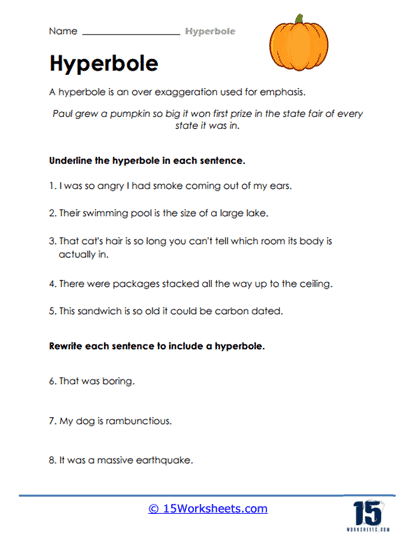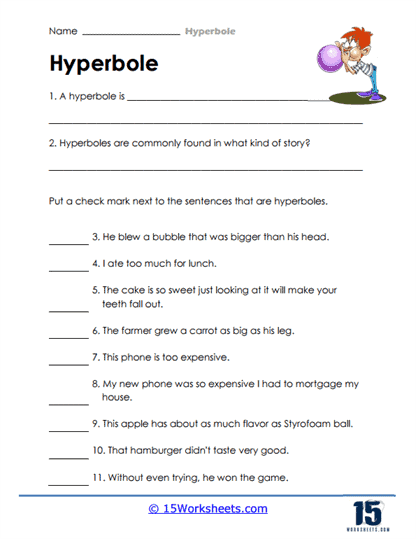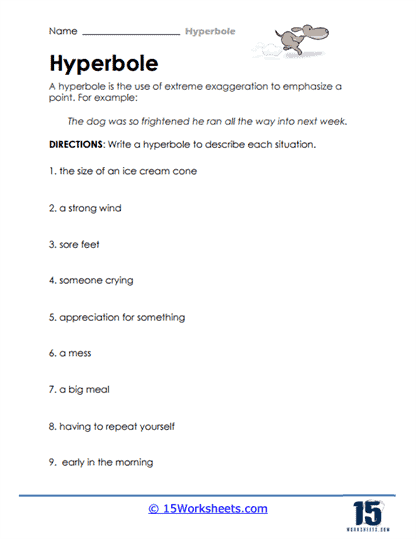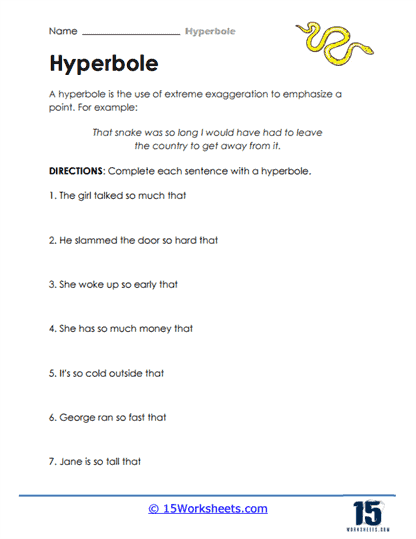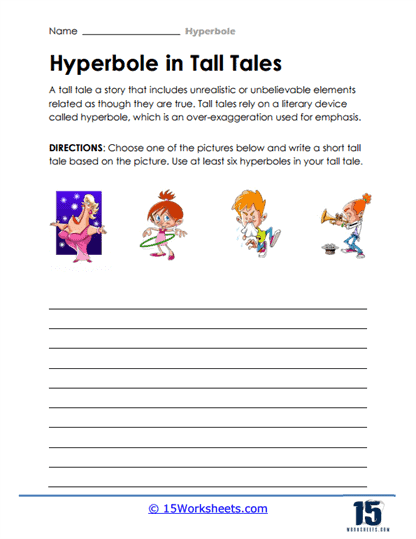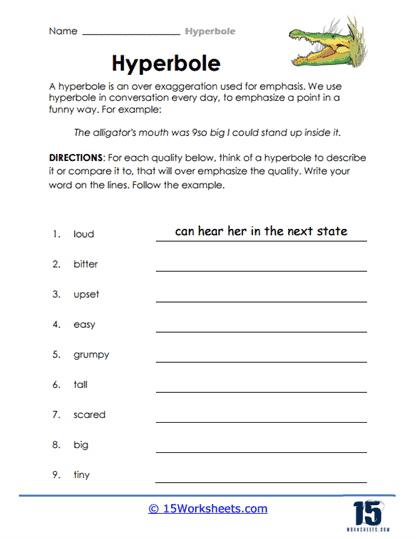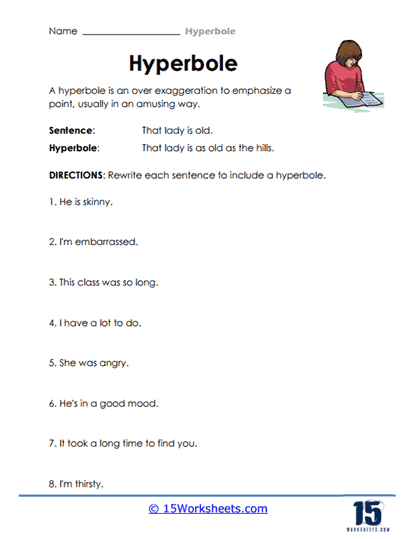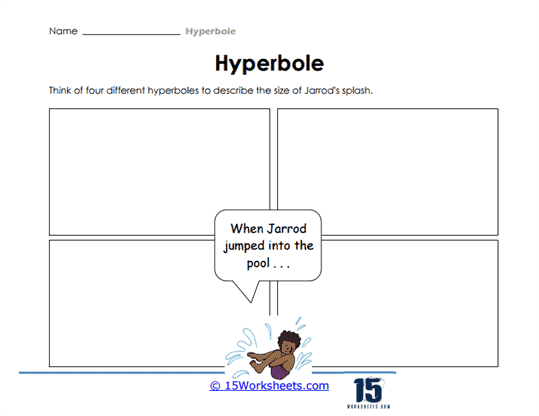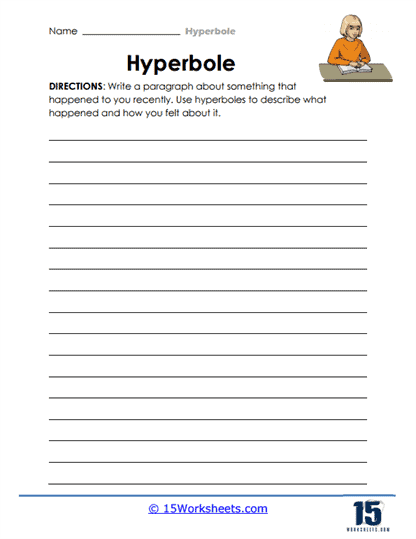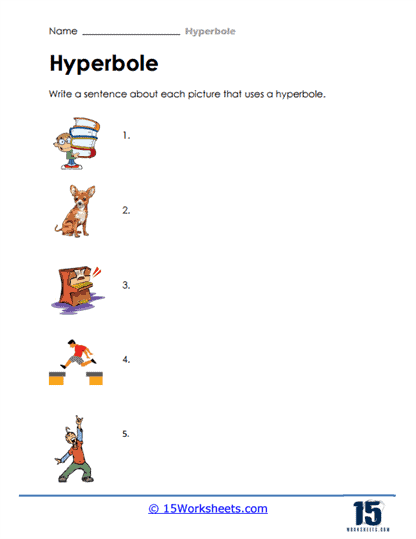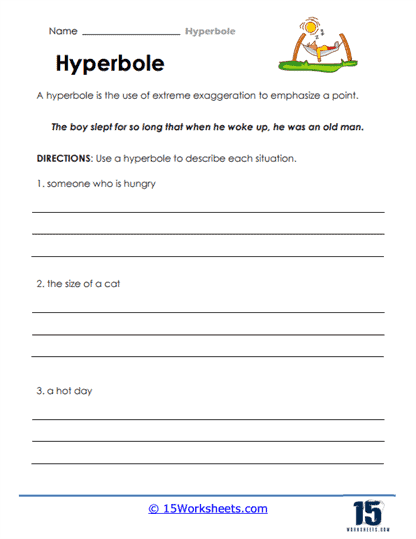Hyperbole Worksheets
About These 15 Worksheets
These worksheets will help you understand and practice the use of hyperbole in language. Hyperbole is a figure of speech that involves exaggerated or extravagant statements that are not meant to be taken literally. It’s a way of emphasizing a point or adding dramatic effect to our communication.
To explain hyperbole, let’s look at an example – Imagine someone saying, “I’m so hungry, I could eat a horse!” This statement is a hyperbole because it exaggerates the person’s hunger to an extreme level. We don’t actually expect them to eat a whole horse, but it helps us understand just how hungry they are.
Hyperbole worksheets provide exercises and activities that help you recognize and analyze hyperbole in texts. These worksheets often contain sentences or passages where you have to identify instances of hyperbole and understand the exaggerated meanings behind them.
By working on hyperbole worksheets, you can work on:
Identification – Hyperbole worksheets help you develop the skill of recognizing hyperbole in language. By reading sentences or passages, you learn to identify statements that go beyond literal meanings and use exaggerated language for emphasis. This skill allows you to appreciate the creativity and impact of hyperbole.
Understand Exaggeration – Hyperbole worksheets allow you to analyze the nature of exaggeration in hyperbolic statements. You explore how hyperbole adds emphasis, intensity, or humor by using extreme and exaggerated language. By understanding hyperbole, you gain insight into the power of language to make a strong impression.
Enhance Writing Skills – By learning about hyperbole, you enhance your writing skills. Hyperbole provides a tool to make your writing more engaging, expressive, and memorable. By practicing hyperbole through worksheets, you develop the ability to use this figure of speech in your own writing to add emphasis or create a specific effect.
Appreciate Figurative Language – Hyperbole worksheets foster an appreciation for the creativity and impact of figurative language. You recognize how hyperbole adds color, humor, and intensity to language, making communication more vibrant and memorable. This awareness helps you appreciate and analyze the use of figurative language in literature and everyday communication.
Recognize Intentional Exaggeration – Hyperbole worksheets help you differentiate between literal statements and intentional exaggeration. By working on these worksheets, you learn to identify instances where hyperbole is used for effect and not to be taken literally. This skill allows you to understand the intention behind exaggerated statements and interpret them appropriately.
What Is Hyperbole?
Hyperbole is a figure of speech that involves exaggerated or extravagant statements not meant to be taken literally. It is used to emphasize a point, create humor, or add dramatic effect to our language. Here are five examples of hyperbole:
“I’m so hungry, I could eat a horse!” – This statement exaggerates extreme hunger by suggesting the person is capable of eating a whole horse, emphasizing their intense appetite.
“I’ve told you a million times!” – This expression exaggerates the number of times something has been said to emphasize frustration or the perception of repetition.
“She’s as thin as a toothpick.” – This simile compares a person’s thinness to the slimness of a toothpick, exaggerating their slender figure for emphasis.
“This bag weighs a ton!” – This statement exaggerates the weight of a bag to emphasize its heaviness, even if it is not literally weighing a ton.
“I’m so tired, I could sleep for a hundred years.” – This hyperbolic statement exaggerates exhaustion by suggesting the need for an extraordinarily long period of sleep.
Why Do Writers Use Hyperbole In Literature?
Authors use hyperbole as a form of figurative language in literature for several reasons:
Emphasizing a Point – Hyperbole allows authors to emphasize a point or idea by exaggerating it. By using exaggerated language, authors can make a strong impression on readers and draw their attention to specific aspects of the story. Hyperbole helps create memorable moments and emphasizes the importance or significance of certain elements in the narrative.
Evoking Emotions – Hyperbole can evoke strong emotions in readers. By using exaggerated statements, authors can intensify the emotional impact of a scene or character. Whether it’s to convey extreme joy, deep sadness, overwhelming fear, or immense surprise, hyperbole heightens the emotional response and creates a more vivid and engaging reading experience.
Adding Humor – Hyperbole is often used to create humor in literature. By stretching the truth to extreme proportions, authors can elicit laughter from readers. Hyperbolic statements that are clearly exaggerated or impossible in reality can be entertaining and amusing. They create a sense of playfulness and lightheartedness, adding comedic elements to the story.
Creating Vivid Imagery – Hyperbole helps authors create vivid and imaginative imagery. By using exaggerated language, they paint vibrant pictures in the minds of readers. Hyperbolic descriptions make the scenes more vibrant, the characters more memorable, and the settings more immersive. Hyperbole enhances the visual and sensory experience of the story, allowing readers to form vivid mental images.
Highlighting Irony or Contrasts – Hyperbole can be used to highlight irony or contrasts within the narrative. By juxtaposing extreme statements with reality, authors create a sense of irony or emphasize the differences between expectations and reality. This technique adds depth and complexity to the story, encouraging readers to consider the contrasts and underlying meanings within the text.





